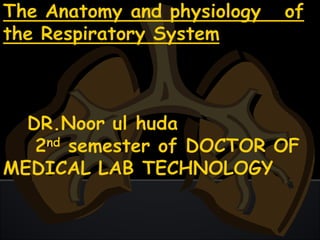Respiratorysystem
- 2. “Respiration” is used several different ways: Cellular respiration is the aerobic breakdown of glucose in the mitochondria to make ATP. Respiratory systems are the organs in animals that exchange gases with the environment. “Respiration” is an everyday term that is often used to mean “breathing.”
- 3. Respiratory systems allow animals to move oxygen (needed for cellular respiration) into body tissues and remove carbon dioxide (waste product of cellular respiration) from cells.
- 4. -contraction of diaphragm and intercostal muscles
- 5. relaxation of diaphragm and intercostal muscles
- 6. Air Distributor Gas exchanger Filters, warms, and humidifies air Influences speech Allows for sense of smell
- 7. Upper respiratory tract (outside thorax) Nose having tiny hairs Nasal Cavity soft and hard plate Sinuses air cavities Pharynx
- 9. Lower respiratory tract (within thorax) Trachea Bronchial Tree Lungs
- 11. Nose - warms and moistens air Have nasal conchae with small spaces dilates in winter, Sinuses - 4 air containing spaces – open or drain into nose - (lowers weight of skull).
- 12. Pharynx (throat) Base of skull to esophagus 3 divisions Nasopharynx - behind nose to soft palate Oropharynx - behind mouth, soft palate to hyoid bone. Laryngopharynx hyoid bone to esophagus.
- 13. Larynx (Voice box ) help in phonation Have no work in respiratory system.
- 14. Trachea (windpipe) Larynx to bronchi Consists of smooth cartilage and C shaped rings of cartilage. Tracheostomy - cutting of an opening in trachea to allow breathing.
- 16. The diaphragm pulled the oxygen down to the bronchi and into the lungs. Then, it goes into a million moist air sacks which expand and contract like a sponge with water.
- 17. Lungs: Divided into 2 lobes Left lung is smaller than right.
- 18. Bronchi: Tubes that branch off trachea and enter into lungs Ciliated Bronchioles: branch into microscopic alveolar ducts. Terminate into alveolar sacs
- 19. The alveoli are moist, thin- walled pockets which are the site of gas exchange. A slightly oily surfactant prevents the alveolar walls from collapsing and sticking together. Gas exchanging done here by diffusion.
- 24. Malfunctions & Diseases of the Respiratory System asthma severe allergic reaction characterized by the constriction of bronchioles bronchitis inflammation of the lining of the bronchioles emphysema condition in which the alveoli deteriorate, causing the lungs to lose their elasticity pneumonia condition in which the alveoli become filled with fluid, preventing the exchange of gases lung cancer irregular & uncontrolled growth of tumors in the lung tissue

